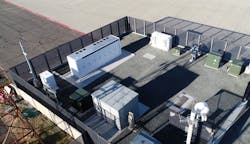San Diego Utility, California and federal Firefighters welcome new Battery-Storage Microgrid for Backup Power
A new microgrid completed by San Diego Gas & Electric will help aerial firefighters stay ahead of and above high-level blaze dangers.
SDG&E has finished work on the 100-percent battery-storage microgrid. The facility provides backup power to the Ramona Air Attack Base, home to CAL FIRE and the U.S. Forest Service’s aerial firefighting units.
Ramona is one of four microgrids planned within the High Fire Threat District aimed at protecting rural southern California communities. California wildfires have caused close to $100 billion in real damages since 2017, according to reports.
“As climate conditions continue to worsen, it’s imperative that we develop innovative solutions to support the continuity of essential resources, particularly our region’s emergency response resources, so they are ready for deployment at any moment,” said SDG&E CEO Caroline Winn. “The completion of the Ramona microgrid is a milestone in our ongoing partnership with CAL FIRE and the U.S. Forest Service as we work to make our electric system safer, cleaner and more reliable.”
See our full coverage of Mission Critical Microgrid projects
The Ramona grid is powered completely by 500-kW/2,000-KWh in battery storage capacity. It can be utilized to keep critical facilities energized when utilities undertake public safety power shutoffs (PSPS)—such as de-energizing certain transmission and distribution line systems—during periods of high wildfire risk.
“The U.S. Forest Service depends on the Ramona Air Attack Base to protect communities within and adjacent to the Cleveland National Forest,” said Scott Tangenberg, U.S. Forest Service Supervisor. “The ability to use aircraft to help suppress catastrophic wildfires is a critical tool in our fire suppression toolbox.”
CAL FIRE staffs the Ramona Air Attack Base year-round with one OV-10A Bronco tactical aircraft and two S-2T airtankers. These aircraft support wildland fire suppression locally and can be requested to assist with fires throughout California. Additionally, the base houses the U.S. Forest Service’s Bell 205 A++ helicopter and crew.
Mission-critical entities within the state of California are increasingly turning to microgrids which can operate independently of the main utility systems. These microgrids can offer both emissions reduction and energy resiliency services.
-- -- --
(Rod Walton, senior editor for EnergyTech, is a 14-year veteran of covering the energy industry both as a newspaper and trade journalist. He can be reached at [email protected]).
Follow us on Twitter @EnergyTechNews_
Sign up for Energy Technology eNewsletters
SIGN
About the Author
Rod Walton, EnergyTech Managing Editor
Managing Editor
For EnergyTech editorial inquiries, please contact Managing Editor Rod Walton at [email protected].
Rod Walton has spent 17 years covering the energy industry as a newspaper and trade journalist. He formerly was energy writer and business editor at the Tulsa World. Later, he spent six years covering the electricity power sector for Pennwell and Clarion Events. He joined Endeavor and EnergyTech in November 2021.
Walton earned his Bachelors degree in journalism from the University of Oklahoma. His career stops include the Moore American, Bartlesville Examiner-Enterprise, Wagoner Tribune and Tulsa World.
EnergyTech is focused on the mission critical and large-scale energy users and their sustainability and resiliency goals. These include the commercial and industrial sectors, as well as the military, universities, data centers and microgrids. The C&I sectors together account for close to 30 percent of greenhouse gas emissions in the U.S.
He was named Managing Editor for Microgrid Knowledge and EnergyTech starting July 1, 2023
Many large-scale energy users such as Fortune 500 companies, and mission-critical users such as military bases, universities, healthcare facilities, public safety and data centers, shifting their energy priorities to reach net-zero carbon goals within the coming decades. These include plans for renewable energy power purchase agreements, but also on-site resiliency projects such as microgrids, combined heat and power, rooftop solar, energy storage, digitalization and building efficiency upgrades.

